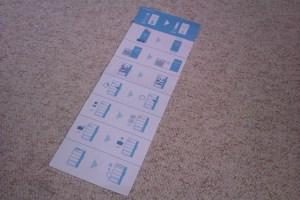There is lots of chatter about Big Data and how it has the potential to transform many aspects of our daily lives, whether it’s in terms of improving our bodies or what we buy. As a counterpoint, I want to highlight three examples which would be regarded as rather ‘data-lite’ and distinctly low tech, but which are still very powerful.
My first example is the instruction/care leaflet that came with a new fridge. As fridge manufacturers now sell their products across the globe, they need to make sure that any documentation given to customers is available in many different languages. This means you can often end up with those rather annoyingly bulky booklets with 90% of the content redundant to you. Or else you can have what I found – which is a completely visual leaflet telling you everything without any words. It is a neat solution and I think it just about works.

My second examples is from an article in The Economist, which describes an invention by Mohammad Abdul Quaiyum of the International Centre for Diarrhoeal Disease Research in Dhaka. The invention is a standardised birth mat, which helps reduce the risk of women bleeding to death after having given birth.
Losing more than half a liter of blood after childbirth is a sign of trouble. Dr Quaiyum’s mat, a 50cm square made of cotton and tissue paper, is therefore designed to absorb just over 400 millilitres. If it gets saturated, the midwife should seek medical help for the mother immediately. Of those 77,000 new mothers who had given birth using kits updated with the new mats, 37 fewer than expected died.
My final example also happens to be from an article in the same edition of The Economist describing the ‘humble hero’ that is the shipping container. According to new research, the container has been more of a driver of globalisation than all trade agreements in the past 50 years taken together. Though it is essentially just a big metal box, its introduction in the 1950′s brought many advantages over the existing system (men would try to squeeze as much cargo in as possible, taking up valuable time and often siphoning off a small part of the cargo off for themselves). With the containers, things improved across many different areas.
In 1965, dock labor could move only 1.7 tonnes per hour onto a cargo ship; five years later a container crew could load 30 tonnes per hour. This allowed freight lines to use bigger ships and still slash the time spent in port. The journey time from door to door fell by half and became more consistent. The container also upended a rigid labor force. Falling labor demand reduced dockworkers’ bargaining power and cut the number of strikes. And because containers could be packed and sealed at the factory, losses to theft (and insurance rates) plummeted.
So it seems it is possible to receive information without written instructions, save lives with a bit of cotton and tissue paper, and stimulate global prosperity with big metal boxes.
